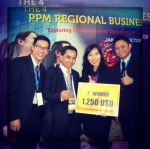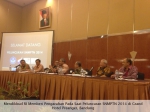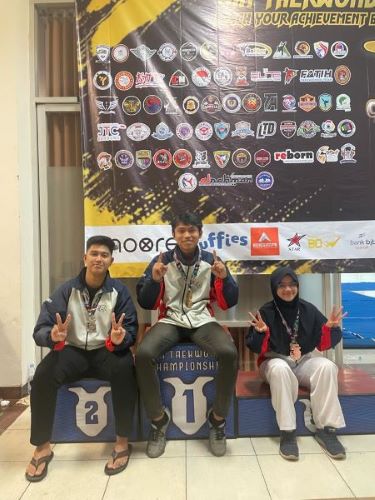SAPPD ITB Webinar: Responding to Digital Transformation in the Area of Policy Design, Planning and Development
By Adi Permana
Editor Adi Permana

BANDUNG, itb.ac.id – School of Architecture, Planning and Policy Development of Institut Teknologi Bandung held a webinar on Thursday (1/7/2021). The webinar celebrated 101 years of Technical Higher Education in Indonesia (PTTI). In this first session, the SAPPK VE-01 Webinar discussed a topic titled Beyond Boundaries: Digital Transformation in the field of Policy Design, Planning, and Development.
SAPPD ITB presented some well-known people, educational names as speakers and responders in this webinar. Ridwan Sutriadi, S.T., M.T., Ph.D. from Urban Planning and Design Research Group of SAPPD ITB performed as the first speaker with the topic "Digital Transformation: Research Progress on Smart City from the Side of City Planners". Aswin Indraprastha, S.T., M.T., M.Eng, Ph.D. from Architectural Design Research Group of SAPPD ITB became the second speaker with the topic "Beyond the Stable State: Understanding Transformation in Architectural Planning".
Ir. Bernardus R. Djonoputro, MM., IAP. as executive director of Ernst & Young Indonesia and Prof. Ir. Gunawan Tjahjono, M.Arch, Ph.D. as professor of the Department of Architecture, Faculty of Engineering, University of Indonesia were the responding side. The Dean of SAPPD ITB, Dr. Sri Maryati, S.T., MIP., who delivered the opening and remarks as the host of this webinar, was also presenting. The webinar host was Dr. I Gusti Ayu Andani, S.T., M.T. from Regional and Urban Planning Research Group of SAPPD ITB.
Ridwan Sutriadi, in the first presentation, explained the effects of digital transformation in detail. He explained the impact in academics and research, also in general, on urban planning. In urban planning, digital transformation was the basis for initiating a smart city and a cyber city. He described the digital transformation timeline in further discussion and the transformation of smart city development on a national and global scale.
A smart city has three characteristics: bright, innovative, and inclusive. Thus, a smart city was not only related to technology and digitalization but also the transformation of its resident's behaviour and point of view. It was principally about their innovation and inclusivity as the most important thing. Then, Aswin Indraprastha continued the second session of the webinar. He discussed digital transformation in the education of architecture planning. He started the discussion by giving a hypothetical question: what will happen to the architecture when the technology saturation is getting close?
"The I.T. along with the computerized methods will transform the process of designing and creating, from the linear to the participatory impact. It means an architect is not the only agent who processes the abstract design to the implementation. There will be lots of agents to involve," said Aswin.
Aswin mentioned that there should be a situation for such a condition. Aswin also said that there should be a learning system that delivers various and more active learning options to new kinds of knowledge that will occur. "The world is changing rapidly. Pandemic makes things worse into a catalyst. So we should plan and implement the learning process that focuses on studying experiences," he continued.
Again, Aswin discussed the context of architectural education. He explained that the pandemic did affect not only design techniques but also designing creativity and paradigms. Architecture students who are used to think freely need to be trained to think with a more deterministic approach. One of which was by exploiting abstractive thinking processes in formal algorithmic methods.
"We should find some innovations because the situation is beyond our expectations. It is why we should change ordinary things into actions that are beyond the stable state," he claimed.
Then, Ir. Bernardus R. Djonoputro discussed the topic: "Are You Reframing Your Future or Is The Future Reframing You?" in responding to the former spokesman's presentation. He stated that there are megatrends and major scenarios that occur, particularly during the pandemic. He said that everyone should be ready with tactical steps for investing resources more efficiently.
"I think we're approaching the new renaissance in the planning and design process," said Ir. Bernardus.
Prof. Gunawan Tjahjono also gave his response by discussing fundamental issues that relate to design and planning. He claimed that the problem that constantly creates new obstacles is a fundamental one that designers experience. However, dealing with a wicked problem could not be done by an input-output method. Therefore, it was crucial to pay attention to several things in designing: for what and for whom?
The webinar allowed all speakers and responders to explain their subjects. Afterwards, Dean of SAPPD ITB, Dr. Sri Maryati closed the webinar by stating her closing statements.
"There should be some changes to prepare for the upcoming program. It means there are several things that we need to accomplish to develop education, research, and people integration in design, planning, and policy development. Then, we should consider how we can collaborate by welcoming the future of our education by creating some transformations that we should follow in the future," she said.
Reporter: Achmad Lutfi Harjanto (Perencanaan Wilayah dan Kota, 2020)
Translator: Zahra Annisa Fitri (Perencanaan Wilayah dan Kota, 2019)

.jpg)
.png)
.jpg)
.jpg)
.jpg)



